Introduction
The United Nations Millennium Project, “The Capacity to Decide,” identified decision-making as one of the top 15 global challenges facing humanity today! It is easy to understand why decision-making viewed with such acclaim is a critical soft skill for most monumental public and private sector investment, resource allocation, and control decisions by women and men in leadership and managerial roles. These days, it is a priority for successful organizations to make rapid, knowledge-based, and high-quality strategic and tactical decisions that support their corporate strategic framework. The principal responsibility of business management, in most industrial environments, is, above all, to make smart decisions on an ongoing basis!
In psychology, decision-making is the cognitive practice of identifying and choosing alternatives based on the values, predisposition, favorites, and opinions of the decision-maker. The act accordingly is a social event that can be rational or irrational and based on explicit and tacit knowledge and personal biases.
Management at all organizational levels is designated decision-makers. However, how these individuals speak to and support the decision-making process varies based on their position within the corporate hierarchy. To progressively climb the management ladder, managers need to continually acquire and hone new skills and behaviors to accommodate the manner they use information and knowledge to create and evaluate strategic and tactical choices.
“Managers at a typical Fortune 500 company may waste more than 500,000 days a year on ineffective decision making.”
McKinsey & Company
Market research and real-world experience suggest that timely and effective decision-making is a direct consequence of the executives’ and managers’ ability to understand the nuisances and details associated with impending decisions. Only with decision classification, focus, and prioritization can be associated with the appropriate knowledge and insights necessary to make the required decision.
 Decision-making is a primate critical success factor for competitive advantage and value creation. In this context, the resultant quality of decisions could be the critical differentiator and foundation of their Strategic Alignment Model. Decision types, as shown in the side graphic, represent vital corporate decision points.
Decision-making is a primate critical success factor for competitive advantage and value creation. In this context, the resultant quality of decisions could be the critical differentiator and foundation of their Strategic Alignment Model. Decision types, as shown in the side graphic, represent vital corporate decision points.
Making business decisions appropriately and quickly is mission-critical to ensuring a successful business story. Why is it so tough to make decisions? Possibly it is because the variables and the results are often ambiguous given the heavy influence of the human and enterprise cultural convergence, with decision-makers actively involved in a range of vital strategic and tactical decisions. Decision-making is an imperfect act that produces discomfort and analysis paralysis! It’s not easy to predict the business future, but hindsight is 20/20, so it is easy to realize the right choice after something has happened. The sad reality is that some adverse decisions will occur as part of corporate life mechanics.
History beset with questionable and misguided business decisions has led to many Fortune-listed companies’ financial decline, competitiveness erosion, and reorganization with bankruptcy, merger, or acquisition outcomes. Even the most innovative and technological-advanced firms can miss the mark when it decides whether to take advantage of a commercial opportunity.
In the saga of ‘big-bet’ business paradigm-changing decisions, over the years, only a small percentage proved fatal as it is not easy to destroy a company with a single decision. That is true when the business is currently benefiting from an environment marked by attractive products and services, large and growing revenue, and a chronicle of market success. But not all abysmal decisions are created equal as troubled choices can also produce an acrimonious cycle that reinforces an already unsettling business management personality and behaviors among executive decision-makers.
The above graphic highlights some of the more significant corporate blunders that are the subject of many graduate school case studies.
Lesson-learned from the 20th century and current 21st century is a testimony that no business can reach its full potential without their management team making quality decisions to support the achievement of approved strategies and associated financial goals on a timely basis. Also, from these historical experiences, we learn that it’s easy for companies to expose themselves unnecessarily to risk by working around or avoiding formal decision practices when it suits their purpose!
“Bad decisions are like Trojan horses—you may not recognize the danger at first, but if you know your history, you’ll learn to keep them outside your walls.”
Bain & Company
Decision-Making Impediments
The business environment has many problematic and overriding impediments, as shown below that obstruct managers and other responsible employees from making intelligent value-based strategic and tactical decisions.
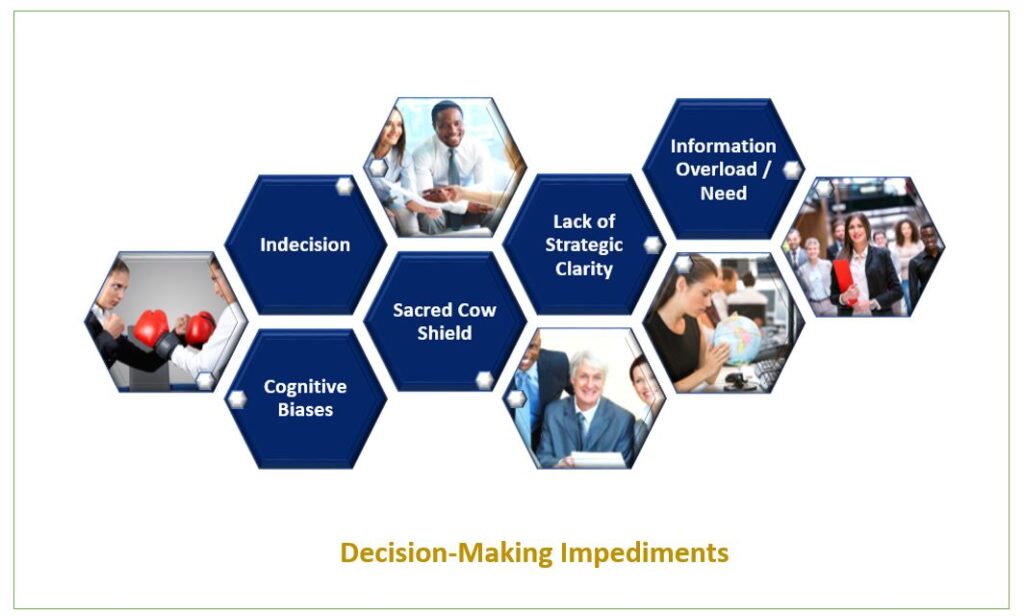
Indecision
Indecision is a mechanism the human ego uses to safeguard people from potentially threatening and risky situations! People primarily experience indecisiveness out of the fear of making missteps or blunders fueled by overthinking. Trepidation of making the wrong decision is a crucial driver for many people when faced with a choice.
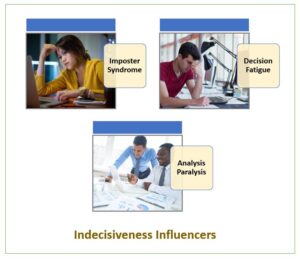 Being in a constant state of indecision can be stressful as it embroils individuals in a dangerous cycle of anxiety beset by unnecessary worry.
Being in a constant state of indecision can be stressful as it embroils individuals in a dangerous cycle of anxiety beset by unnecessary worry.
Human indecision conditions tend to be influenced by the imposter syndrome, decision fatigue, and analysis paralysis as outlined below.
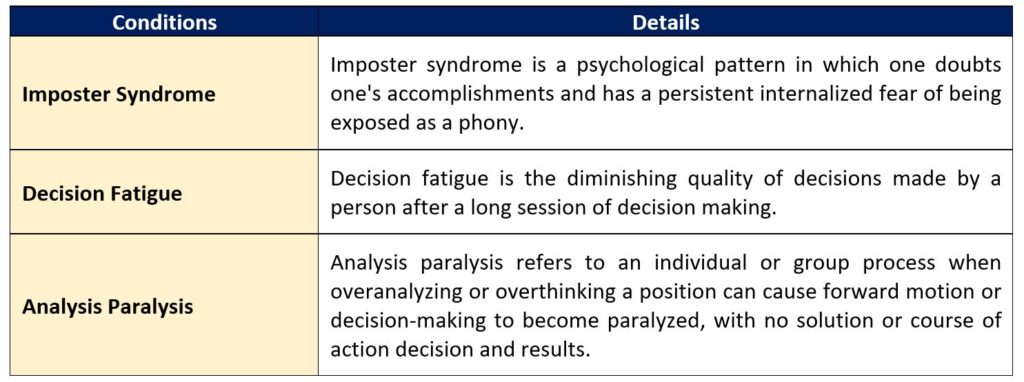
Research into the psychology of indecision supports adverse effects that limit personal success in family, social, and workplace relationships. Uncertainty becomes dangerous when it occurs for an extended period. For example, will a critical opportunity be squandered? Will a problem manifest into a loss? Is the decision becoming tougher to make later than sooner?
Indecision, in particular circumstances, may also deliver positive benefits as it provides additional valuable time to study, reach conclusions, and make decisions. However, it is essential not to let a state of indecisiveness keep the potential decision stuck forever. Similarly, decision-makers decide by default if they fail to make the appropriate decision on a timely basis.
Forbes reports:
“Chronic indecisiveness can be one of the toughest psychological demons to banish. Here are seven ways to help you pull the trigger when a big part of you would rather do anything but.”
“Forget About Always Appearing Smart.”
“Trust Your Gut (It’s Savvier Than You Think).”
“Beware the Paradox of Choice.”
“Prioritize Your Demands (and Fears).”
“Channel Winston Churchill.”
“Accept the Limits of Analysis.”
“Flip a Coin.”
Cognitive Biases
Cognitive biases result in systematic errors in thinking, part of our brain’s hardwiring, that triggers people to act irrationally, often resulting in a deviation from logical decision-making. These biases are very human and arise from our need to make sense of a situation before deciding on a course of action. Most people are unaware of their subconscious biases, but often making the same senseless mistakes because of them continually.
One and all are susceptible to forming cognitive biases, the unconscious drivers that influence our judgment and decision-making in the family, social, and workplace interactions. In some ways, biases are very helpful and adaptive, allowing people to use past experiences and associated insights in current decision-making. At the same time, the biases can be destructive, preventing consideration of a broad range of choices, and limiting the search for additional information. While most business managers are aware of how easy to fall prey to biases, most believe that they are not prejudiced.
According to Nobel prize-winning psychologist Daniel Kahnemann, “….human minds are riddled with a host of cognitive biases that help us act quickly in the face of danger but make accurately weighing evidence, assessing probabilities, and deciding logically often pretty difficult.”
Cognitive biases may lead managers to draw conclusions and make decisions based, not on evidence, but a particular predisposition of their mind. There are over 180 recognized cognitive biases categorized within decision making and behavioral, probability and belief, and social biases.
A partial list of notable preferences linked with decision-making includes the below.
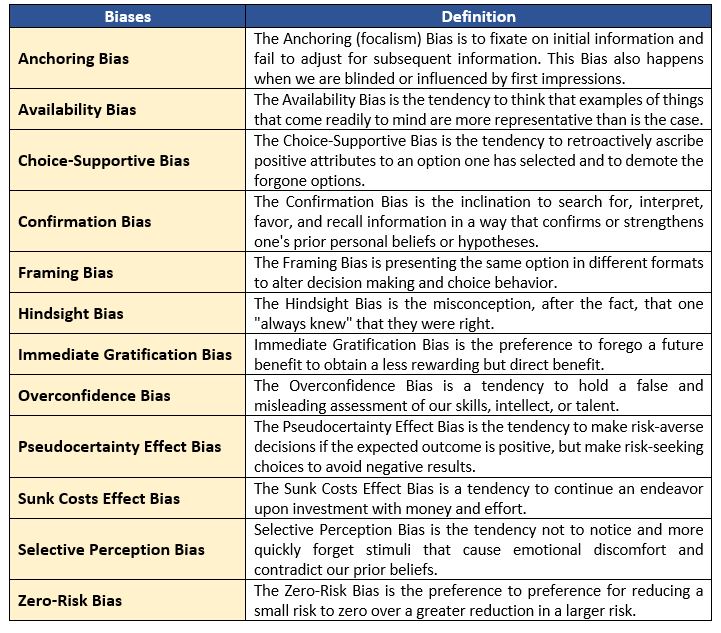
Debiasing (cognitive bias mitigation) is the practice to reduce the negative influence of cognitive biases. The goal is to think more rationally, eradicate, or lessen potential errors, distortions, or other mistakes in people’s thinking, reasoning, judgment, and decision making. Most seasoned executives and managers are cognizant of the impacts of negative biases in the workplace. Yet, awareness alone cannot surmount predispositions, as they can be embedded deep in our individual and organizational thought processes.
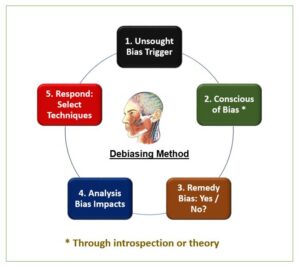 Best practices support the use of a structured method, with the example shown alongside, for improved debiasing results realized by individual employees, groups and teams, and the organization.
Best practices support the use of a structured method, with the example shown alongside, for improved debiasing results realized by individual employees, groups and teams, and the organization.
There are many debiasing techniques recognized as useful aids for upgrading business decision-making based on their specific underlying circumstances.
Assimilating these mental practices into the debiasing method, shown above, decreases the probability that biases spontaneously influence decisions and negatively impact the outcomes.
As the populace is imperfect and mortal, the technique results occur to a relative degree than entirely no matter which techniques used.
Debiasing techniques are generally categorized as follows:
- Cognitive focus on how decision-makers conceptualize a problem.
- Motivational include policies on how incentives and punishments are employed to improve decision-making.
- Technological involve the use of computers and other technologies employed to assist in problem-solving.
“If a decision-making process is flawed and dysfunctional, decisions will go awry.”
Carly Fiorina
Sacred Cow Shield
In many businesses, there are “sacred cows” that are revered or feared. These are concepts and practices so entrenched that most employees don’t even think to question. Once, those artifacts may have made sense and value, but unintentionally, they become sacrosanct over time. However, during this period, the economy, marketplace, regulations, and customers have experienced continually change. But today, these traditional corporate mindsets, locked firmly into the past, aren’t infallible, and many results in bad business decision-making in the business environment.
Most companies in business for an extended period have ‘sacred cows’ in their mist involving employees, culture, technology, and processing, without being challenged, critiqued, or corrected as they are deemed exempt from reproach. Often, these relics of the past successes are exempt from attack and protected due to misguided loyalties, policies, habits, or current day executives not knowing how to deal with the underlying problems without exposing themselves to pushback and acrimony.
How are Sacred Cows created in the workplace?
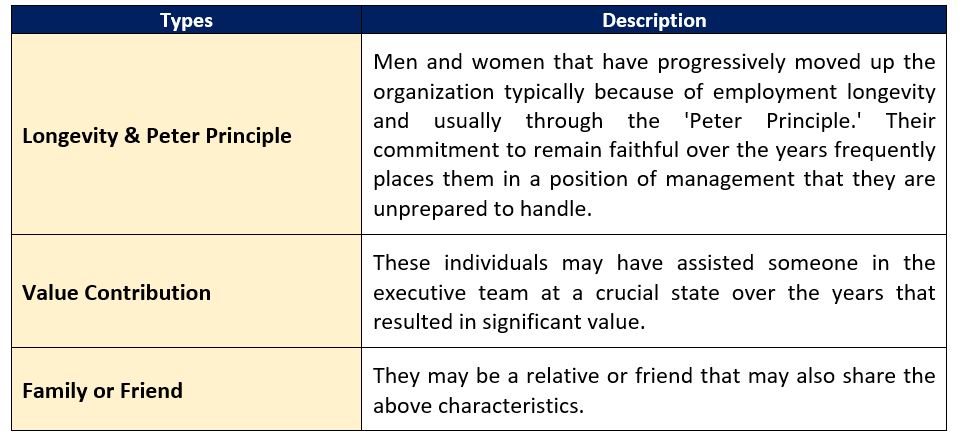
Sacred cows influence, or obstruct both strategic and operational decisions, progress, and perpetuate noxious thinking and beliefs within the workplace. They tend to be emotionally disruptive and can quickly wreck team dynamics resulting in organizational dysfunction. There is a high cost of allowing sacred cows to continue to grass in the corporate pasture in both financial and non-financial terms and deference for organizational leadership.
“It is hard to imagine a more stupid or more dangerous way of making decisions than by putting those decisions in the hands of people who pay no price for being wrong.”
Thomas Sowell
Information Overload / Need
Smart managers generally know and appreciate when to move precipitously and progress with the current information, versus when to take more time and gather additional information. The real challenge, in these situations, is to obtain just a sufficient amount to allow the decision-maker to productively arrive at the necessary conclusion quickly without producing an overload event. When managers choose to pursue further information collecting, they must also know when to terminate their pursuit and move ahead to analysis and conclusions. While a large amount of material may be desirable in a perfect world, this activity typically expends unnecessary employee production time and money, and the vast amount may be paralyzing to analyze and easily support sound decision-making. When we experience information overload, our brains reach their cognitive limit, and decisions suffer enormously.
Nowadays, the search for suitable information can be problematic as sources may be unreliable, the material of poor quality, false, incomplete, ambiguous, and displayed in a manner that makes it difficult to interpret, understand and use.
Information Overload
Information (including data) overload can also be described as information anxiety, infobesity, intoxication, and information explosion. Information overload represents the difficulty in understanding a matter at hand that effectively results in conducting an extensive review of information collections. It is also a state where the accumulated decision cues comprise large sets of diverse reasoning and intricacy material that compel delays and impede timely decision-making. Information overload generally ensues when the time required to meet decision-makers’ needs and constraints exceed the time available, resulting in the degradation of decision quality.
The total amount of information that managers operate with today is overwhelming compared to the past. It may appear, on the surface, that more information will improve the quality of decision-making; however, the exact opposite is often the case. The advent of modern information technology has shown to be a primary catalyst for overload circumstances, with the excessive quantity produced, ease of dissemination, and the breadth of the audience reached.
Information overload materializes, in a business context, when the amount of material input to a situation exceeds its processing capacity. Decision-makers generally have limited cognitive processing capacity, and a decline in decision quality and productivity will result from information overload.
Personal negatively with overwhelmed, frustrated, awkward, pressurized, and stressed emotional experiences are likely outcomes of information overload on decision-makers. In turn, these conditions typically result in:
- A lessening of productivity of the decision-makers and supporting resources.
- The quality of the decisions is degraded and lessens the value as a valid choice or set of options.
- A delay in the decision-making process that may prove a risk to time-sensitive decisions.
Practices that have proved successful in reducing the impacts of information overload include:
- Filter information relentlessly.
- Feel free to disregard seemly relevant information based on previous experiences and insights.
- Feel free to make decisions without all the required material; use the 80/20 rule, as needed.
“The fewer data needed, the better the information. And an overload of information, that is, anything much beyond what is truly needed leads to information blackout. It does not enrich, but impoverishes.”
Peter Drucker
Information Need
In all businesses making decisions is a natural and integral part of the operating model. Every decision-maker’s goal is to make the most optimal choices possible with a minimal amount of cognitive strain or effort. Across the board, a combination of capable decision-makers and appropriate information and insights should generate effective decisions to ensure continued growth and achievement of business goals.
Typically, critical business decisions are deferred or changed due to the absence or nonexistence of information, frequent changes in the underlining data, or the manner interpreted. In the age of connective digital technologies and the rise of social media and the digital culture, most information is available internally and externally to meet decision support requirements.
The good news is that some innovative AI / Machine Learning and an array of decision management tools and techniques can mitigate the problems that decision-makers currently experience with information inundation. The specific information processing and handling practices supported by current-day technologies encompass:
- Screening, filtering, selecting, and eliminating irrelevant information in alignment with decision parameters.
- Organizing, sorting, prioritizing, displaying, and providing access to information relevant to the decision event.
In summary, the supporting tools generate analytical findings, conclusions, and recommendations in reports, dashboards, alerts, and innovative graph formats with comprehensive intelligence on the current and future state of the enterprise’s business and financial conditions and trends. The overarching challenge is to give every decision-maker more power to complete relevant analysis in a way that ties back to organizational strategic intent.
Lack of Strategic Clarity
Strategic clarity is a company’s critical competence to clearly describe, effectively articulate, quickly adjust, and properly execute the business goals and strategies. It is the inverse of strategic ambiguity. When decision-makers lose touch with the vital foundations of their business, they disengage with strategic clarity, and bad decisions result. As a result, it becomes more challenging to make the right decisions.
A business strategy and supporting elements that do not directly motivate and provoke the employee population to accept is just a fantasy. Change is difficult, and no matter the path ahead, changes will be required in the operating model and workplace behaviors. For this reason, all employees’ stakeholders need to understand and believe that the company’s direction and plans will ultimately align with the corporate culture and their needs.
The well-established Strategic Alignment Model represents a vital competitive value in today’s modern business enterprise. An organization with highly-formalized and productive policies and practices in place can respond quickly in the face of changing market problems and opportunities. Because they aren’t mishandling resources and dealing with internal inefficiencies, such a business can be far more agile and dynamic in maintaining and communicating its strategic clarity.
Research supports that less than 50% of corporate forward-looking and viable strategies progress to successful deployment. This condition is due primarily because the plan, though approved and endorsed by the executive team, is not fully understood or accepted by those employees responsible for executing.
Unclear strategic clarity driven by political and dogmatic inducements makes it difficult for decision-makers to make objective decisions as they also manage their assigned responsibilities.
Typically, the ambiguous nature of these underlying stimuli doesn’t support their personal beliefs and personality habits, and over time, they are open to making poor decisions without clear strategic clarity. They lost sight of their principal corporate role and responsibilities, making it somewhat impossible to retain momentum and trust from the employees who depend upon them to communicate and support a clear and straightforward organizational direction.
Symptoms of a poorly designed strategic clarity include:
- Excessive Accountability: Too many stakeholders involved with review and approval dilutes actual accountability.
- Decision Rights: Seek support from individuals beyond their corporate mandate.
- Haphazard Communications: An unclear strategic clarity program consisting of descriptions, responsibilities, and organizational values and worker benefits.
- Confusion: Lack of formalized and transparent policies and practices supporting the implementation, updates, and changes to the strategic clarity program.
“As a result, most organizations are not very good at decision making. It’s no surprise that our study of 500 managers and executives found 98% fail to apply best practices when making decisions.”
Forbes
Business Decision-Making Model
Decision-making occurs at every level of an enterprise, advancing in pyramid-like fashion from the operational decisions made every day by lower-level managerial and supervisory employees to far-reaching strategic decisions that require multiple stakeholder decision-making.
For responsible managers to recognize and make the right decisions, they need to develop and continually hone their judgment-based social behaviors with which we are not innately born. Indeed, the decision behavior is a structured but fluid sequence where outcomes are influenced totally by the decision-maker(s) life experience, innate knowledge, insights and beliefs, and personal bias. However, employee experiences can sometimes be a negative influencer that imparts prejudicial and undesirable results. Effective business decisions require formulation on targeted context, environment, supporting information, obstacles and risks, and values of the situation. It has to accomplish quicker than the competitors and ensure that the decisions are practical and can get translated into productive actions.
The business decision-making model is a formalized step-by-step technique allowing responsible employees to solve problems and advancing opportunities by gathering and weighing evidence, examining alternatives, and choosing an appropriate path forward. The use of a process-driven decision-making model supports a more focused, deliberate, and substantiated decisions by formally organizing relevant information and defining alternatives.
In many organizations, operational and some strategic decisions are taken without the use of a formal model as the responsible employees have the experience and skills to associate the current situation, context, and supporting information with past decisions on similar dilemmas and opportunities quickly. In any event, most management teams engage both the use of a formal decision model and empowered seasoned decision-makers sub-consciously to duplicate the same approach.
Decision making is a critical talent in the workplace, particularly for managers and those in leadership roles. Following a logical method, along with an awareness of pertinent challenges, can help ensure positive decision making and outcomes.
There are many variations of business decision-making models and processes. An example of a generic model shown below includes eight phases. Most models require cross-organizational elements of an organization to work in concert.
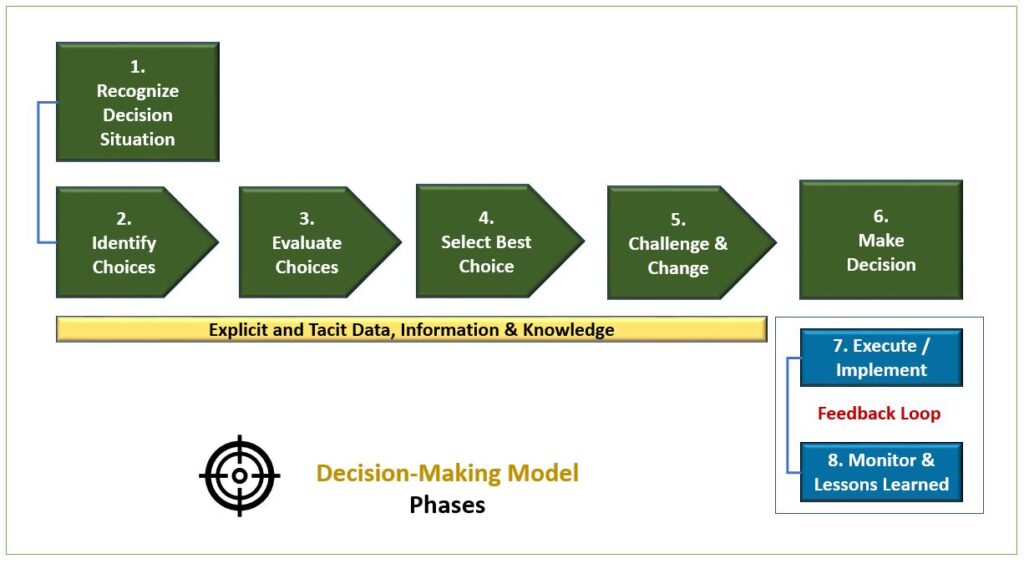
“Effective decisions result from a systematic process, with clearly defined elements that are handled in a distinct sequence of steps.”
Peter Drucker
The below table outlines the Decision-Making Model supporting details.
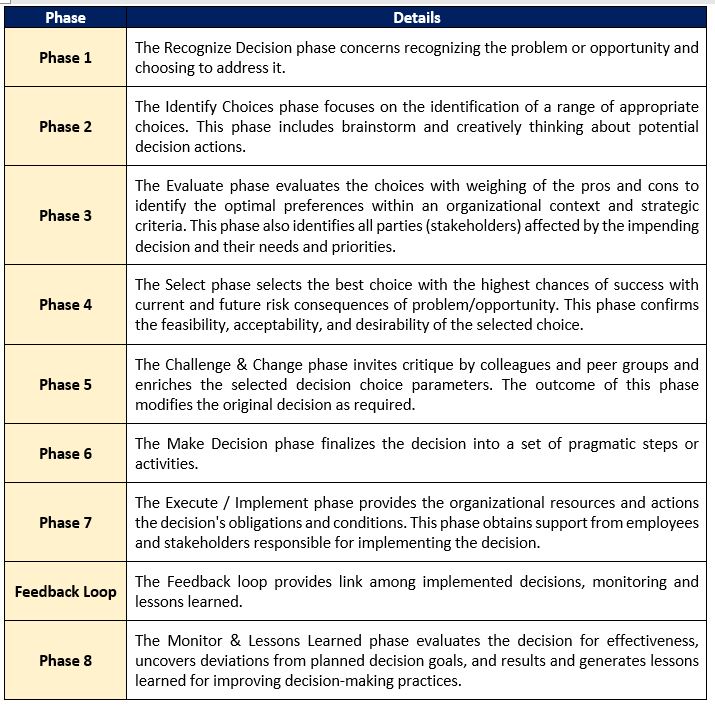
“Senior executives can be judicious with their decision-making time by segmenting decisions into four categories: debate and decide, approve, provide guardrails, and delegate; the latter two are critical to facilitating rapid decision making across the organization.“
Successful decision making takes practice as the practice necessitates a certain level of comfort with discomfort! Exceptional managers place heavy emphasis on their gut as they trust themselves and expertise and tend not to get stuck in the cycle of over-thinking.
The consensus is a well-meaning goal, but as a management practice, it can be a hindrance to the arriving at the best decisions and a formula for accepting the lowest-common-denominator concession. A more helpful way is to motivate the decision stakeholders to take ownership of their choices and outcomes versus a compulsory group consensus.
“Most decisions are not binary, and there are usually better answers waiting to be found if you do the analysis and involve the right people.”
Jamie Dimon
Talented Decision-Makers
When we think of what makes a successful leader, a profile that usually comes to mind is a levelheaded and focused decision-maker! We do not envision successful leaders appearing ambiguous and uncertain, and failing to take necessary actions during turbulent and opportunistic times. Instead, we view these exceptional individuals as men and women who can quickly recognize a decision situation and arrive at the most suitable choice and communicate the related particulars in practical terms.
Fundamental management behavior is the ability to recognize and appreciate how to balance ’emotion with reason’ and make decisions that positively impact employees, customers, and stakeholders without reliance on negative personal bias.
 Making smart decisions in problematic conditions is no small feat as these typically involve doubt, high anxiety, personal stress, and unfavorable responses of others. The best decision-makers are individuals who bring together logic, problem analysis, and intuition to come up with the correct decision.
Making smart decisions in problematic conditions is no small feat as these typically involve doubt, high anxiety, personal stress, and unfavorable responses of others. The best decision-makers are individuals who bring together logic, problem analysis, and intuition to come up with the correct decision.
“Leaders know that making good, fast decisions is challenging under the best of circumstances. But the trickiest are those we call “big bets”—unfamiliar, high-stakes decisions. When you have a crisis of uncertainty such as the COVID-19 pandemic, which arrived at overwhelming speed and enormous scale, organizations face a potentially paralyzing volume of these big-bet decisions.”
McKinsey & Company
The Way Forward
At Knowledge Compass we bring together nearly four decades of thought leadership in business and technology strategy, the latest tools and best practices, and a seasoned consultant team with the competencies and talent to help our clients improve productivity and profitability of all enterprise business and support activities.
Knowledge Compass explores and develops valuable new insights from business, technology, and science by embracing the powerful technology of ideas and brainstorming. Our consultants engage customers in challenging discussion and experimentation to expand the boundaries of business science and practice and translate creative ideas into practical solutions from within and beyond business.
Working with Knowledge Compass means a collaborative approach to understanding your current business model, strategies, and key business requirements and goals.
Knowledge Compass provides consulting services with the use of an array of Frameworks, Analyses Tools, and Interactions from their Best Practices Consultant Toolbox.

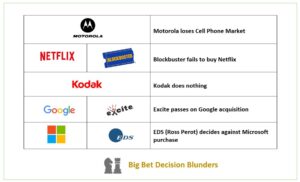



0 Comments